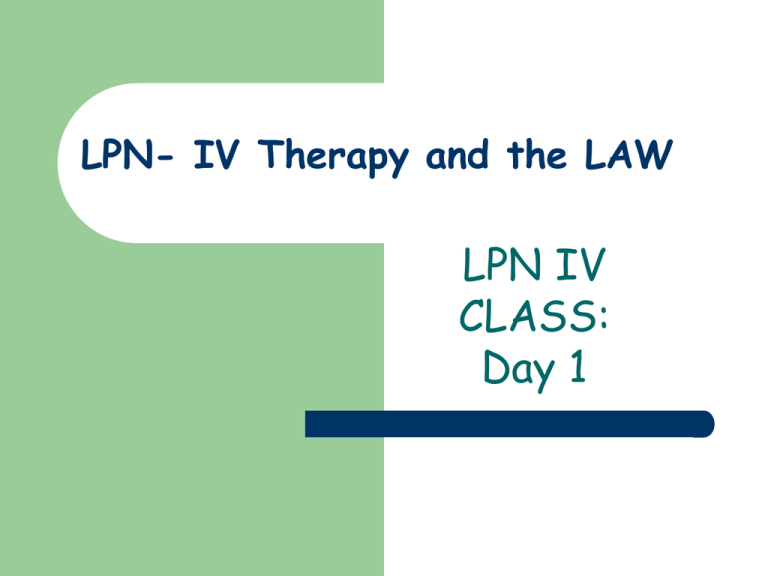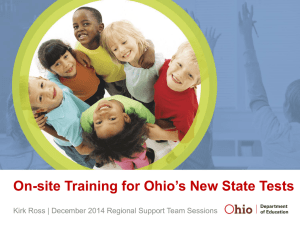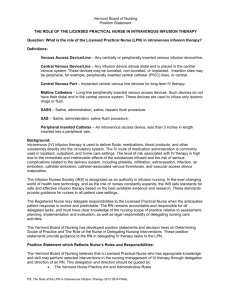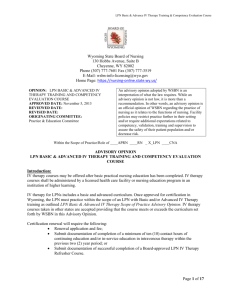Unit_I-Laws_in_IV_therapylv
advertisement

LPN- IV Therapy and the LAW LPN IV CLASS: Day 1 HOUSEKEEPING DUTIES! Course Requirements Evaluations Schedule Content Outline Clinical Homework Book Legal issues related to IV therapy Objectives for this unit are to outline the LPN,s role, accountability, and responsibility relative to IV therapy in terms of law, board rules, role of the directing professional, health care setting and institutional policy Sources of law- four primary sources in the United States Constitution- formal set of rules for gov,t and individual rights Statutes- Federal state and local laws, laws dealing with malpractice Administrative law- Board of Nursing Common- court made law (malpractice) Legal terms Criminal law Civil law Tort- private wrong by act of omission Malpractice- is the form of negligence in which any professional misconduct, unreasonable lack of skill, or non adherence to the acceptable standard of care causes injury to a patient Rule of personal liability- every person is liable for own wrong doing cannot say that it is ok because the doctor told me so – you are responsible to know and know your scope of practice Malpractice Must establish that nurse had a duty to patient A breach of standards of care or failure to carry out that duty must be proven The patient must suffer actual harm or injury There must be a causal relationship between the breach of duty and the injury suffered – – If an act of malpractice does not create harm, legal action cannot be initiated Coercion of a rational adult for placement of IV constitutes assault and battery Breach of Duty Failure to observe Failure to intervene or react Verbal rather than written orders Know your scope of practice Medication errors are an area where nurses face criminal charges what is common cause? LAWS THAT GOVERN LPN PRACTICE Ohio Revised Code: what is it? Ohio Board of Nursing Rules: What makes it different from ORC? Accountability to the law Standards of Practice – – Ohio Board of Nursing Infusion Nursing Society Ohio Revised Code (ORC) Laws that are made and approved by the government of the State of Ohio Laws are adopted by official state offices such as Ohio Board of Nursing Ohio Board of Nursing Rules Ohio Board of Nursing (OBN) is a government agency Must abide by the ORC laws Adopts them as rules to be followed OBN rules can be found on the website Specific rules for LPN IV Therapy – see handout Accountability As nurses, when we accept a license from the state, we agree to follow what the laws of the Ohio Revised Code and rules of the Ohio Board of Rules say we will follow! Standards of Practice VS Standards of Care Standards of Practice govern how we as nurses practice the art of nursing. Standards of Care govern how we provide care to our patients such as policies on starting IVs. Standards of Practice for LPNs in the State of Ohio Ohio Board of Nursing: 4723-4-04 Maintain knowledge Demonstrate competence Provide nursing care according to education Nursing care does not involve a function or procedure which is prohibited by the law Implement regimens in a timely manner Will clarify prescribed regimen when unsure Standards of Practice for LPNs in the State of Ohio Report changes in a timely manner Maintain confidentiality Not disclose patient information unless it will have an adverse affect on their treatment or progress Will evaluate others according to established criteria such as standards of care/practice But I did not Know This excuse will never hold up in a court of law As a licensed professional you are held accountable to know your states nurse practice act and your scope of practice. But I was told to or asked to will not hold up. Board of nursing is responsible for protecting the public from harm. INFUSION NURSING SOCETY (INS) In the INS Scope of Practice: Knowledge of A & P Infusion treatment modalities Participation in the patient’s plan of care Knowledge of infusion therapies Knowledge of psycho/social aspects Collaborate with other team members Breach of duty The nurse does not want to breach standard of practice or violate employer’s policies Five examples of Breach of duty related to IV therapy Delay in administration of medication Unfamiliarity with the drug Inappropriate route of administration Failure to qualify orders Negligence in patient teaching What can any LPN do with IVs (4723.171)? Verify the type of peripheral IV solution being administered Examine peripheral infusion site and extremity for infiltration Regulate peripheral IV according to prescribed flow rate Discontinue a peripheral IV device Perform routine dressing changes at insertion site for: – – – – Peripheral IV Arterial line PICC CVP subclavian infusion What can no LPN do… period! Blood and Blood components TPN Cancer therapeutic medication – – chemotherapy anti-neoplastics Investigational or experimental medications Discontinue: – – – – • • CVP PICC art line any line other than peripheral IV Medications other than antibiotics for those trained. IV push/bolus medications WHAT CAN AN “AUTHORIZED” LPN DO? Initiate IV therapy in hand, forearm or antecubital on an adult(18 and older) Maintain accepted IVs in CVP or PICC lines Prepare or reconstitute an antibiotic medication Verify blood products with an RN Initiate an IV of: – – – – – – D 5W Normal Saline Lactated Ringers 0.45% NaCl 0.25 % NaCl Sterile Water What can we do cont. Hang subsequent containers of accepted IV solutions containing vitamins or electrolytes Initiate and/or maintain IV piggyback of an antibiotic Inject normal saline or Heparin in an intermittent infusion devise or heparin lock Change tubing on IV that terminates in a peripheral vein What does your policy say? Review your policy and see if it meets the requirements of the law. If not, what does it need to add? Who are you going to tell? Role of the RN in delegation What is delegation? LPN can’t delegate IV medication administration Before an RN can delegate the following must be done: Assess patient condition Assess type of care Assess complexity Training and skill of person delegating to Resource availability to perform safely RISK MANAGEMENT What is risk management? Why and how do we ask for informed consent? Why is documentation important with risk management? What is Risk Management INS describes the process as: “ a process that identifies, analyzes, treats and evaluates real and potential hazards.” A risk management program collects and analyzes data to find trends and to help improve practices to increase patient satisfaction and decrease complications and adverse patient outcomes. Risk Management, cont. Looks at areas of actual or high risk Looks at customer satisfaction Works with PI and EOC to provide safest environment Educates Helps facilities complies with federal and state mandates INFORMED CONSENT Proactive strategy because it provides patients with information needed to make and informed decision Medication Errors New systemwide policy Non-punitive Anonymous reporting Investigation into the processes not the person DOCUMENTATION Needs to be timely, accurate and complete Objective Legible Use only accepted abbreviations Don’t use criticism or complaints Every entry dated and timed No vacant space 10 Steps to Medication Safety Know the patient Know the drugs Communicate clearly Beware of look-alike and sound-alike drugs Restrict and standardize drug storage, distribution and stock meds Assess drug delivery devices and maintain competence Watch the environment Educate self Encourage patient participation Target process not person OCCUPATION RISKS Physical hazards – – – – – needle stick injuries abrasions contusions chemical exposure latex allergies Biological Hazards Bloodborne pathogens: – – – – – OHSA regulations Exposures Wearing gloves Using safety devices The most effective way of preventing the spread of disease is...










